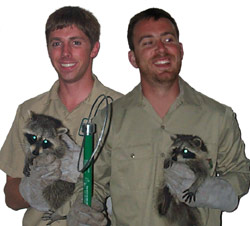
Fort Collins Animal Control
970-454-7205
| Our main office is based out of Denver, but we provide full service to the Fort Collins area, including Windsor, Greeley, and much of Weld County and Larimer County. We are a fully licensed and insured wildlife and pest control company servicing Ft. Collins area. We perform all facets of pest control, and specialize in the humane removal of unwanted wildlife from homes and commercial properties. If you have a problem with a wild critter, such as a raccoon in your garbage cans, a squirrel in the attic, a colony of bats in your building, a mouse or rat infestation, or a problem with pigeons, we can take care of the problem. We have over 15 years of experience, and most of our business is referrals from satisfied customers. Give us a call any time, and we are happy to discuss your wildlife problem, offer you a price estimate over the phone, and schedule an appointment, usually same day or next day. Our number is 970-454-7205. We look forward to hearing from you! |  |
We consider ourselves the best Fort Collins pest control company, and the most skilled at Fort Collins bat control and bird control.
We offer a full range of nuisance wildlife services, and insect control, including Fort Collins termite control, ant, wasp, bee, and cockroach control.
Are there Coyotes in Fort Collins Colorado? Yes. The coyote is a species of canine, which is also called as prairie wolf or American Jackal. Appearance The coyote includes yellowish brown to grayish brown fur above and whitish fur below. They possess triangular ears that are large in size above their heads and a narrow, long muzzle. They also have yellow eyes, a bushy, long tail and a black nose. Biology One easy way to distinguish coyote from the dogs and wolves is to observe their tails when they run. The coyote will run with their tails down. A wolf will run with its tail straight out and a dog will run with their tail up. Life cycle The coyotes mate during the months of February and April. The female might mate in the company of over one male. Two months subsequent to mating, the female will give birth to 1-19 pups; however the average litter size is about 6. The pups are born sightless with floppy ears. The pups undo their eyes in approximately 10 days time. They then start to appear outside their den when they turn 3-4 years old. The young ones are weaned when they turn a month old. Once they become fully weaned, both the female and male will feed the pups with food over and over again. The male young ones will depart from their mother when they turn around 6-9 years old, while the female pups will continue to live with the pack of their mother. The female and male coyotes join and mate in concert for numerous years. Habitat The coyotes can be discovered in various habitats such as plains, fields and bushy spots. Diet The coyote does its hunting at night and without help. The coyote is mainly carnivorous. The majority of its diet consists of mammals; however it also consumes snakes and birds. The coyote chooses to consume freshly killed ones mostly; however it will also consume carrion. During the winter and the fall, the coyote regularly eats vegetables, fruits and berries. While hunting tiny prey such as mice, they stand still on their stiff legs and then swoop on the prey. When it hunts larger prey such as deer, they hunt in groups. One or more number of coyote runs after the deer as the other coyotes wait, and then the next bunch of coyotes will jump back in the chase. When a team of coyotes chases the deer, it might get tired of running, thereby easily becoming their prey. Coyotes also follow badgers and grab hold of animals that pop out of burrow which the badger digs. Behavior Coyotes create their dens in logs, rocky crevices, or other animalís dens. They mostly never dig den on their own. They will discover abandoned badgerís den or a deserted den of a fox and expand it. The coyote is vocal animal and possesses numerous vocalizations such as yips, barks, howls and growls. It will use a long a bowl to allow other coyotes of the pack to know their location. It will use short barks to caution about danger. Whenever a coyote pack welcomes a new member into the pack, the coyotes will yip. Other vocalizations comprise of growls when they establish dominance, whimpering and whining when females and males establish bonds and barks that are high-pitched to assemble puppies. |